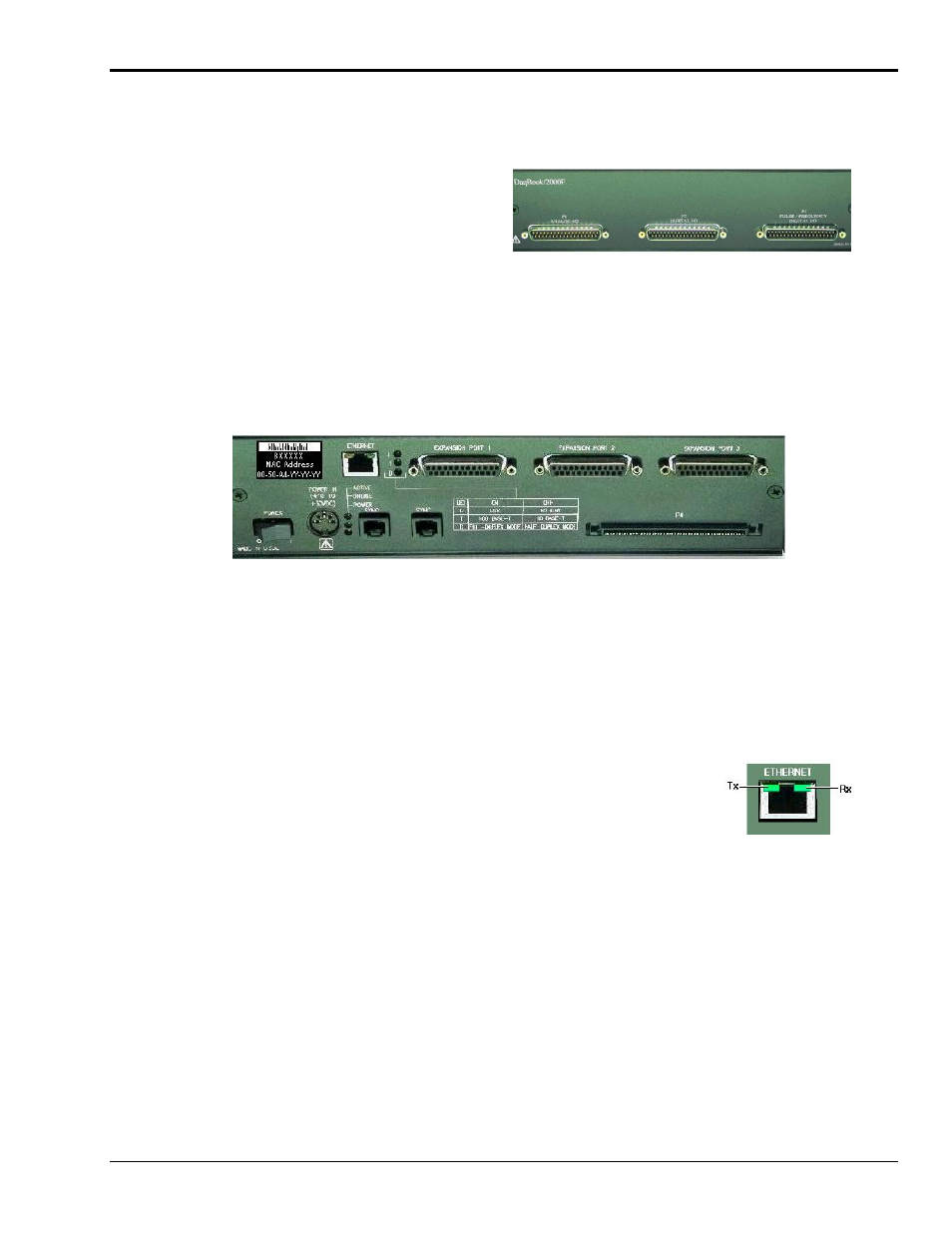Daqbook/2000e – Measurement Computing DaqBook 2000 Series Installation User Manual
Page 31

Appendix D
977296
Device Connector Reference D-5
DaqBook/2000E
Front Panel
The DaqBook/2000E’s front panel offers three
DB37 connectors designated as P1, P2, and P3.
P1 connects to Analog I/O.
P2 connects to Digital I/O.
P3 connects to Pulse / Frequency Digital I/O.
The DaqBook/2000 Series User’s Manual (p/n 1103-0901) includes pinouts for each.
Rear Panel
The upper row of DaqBook/2000E’s rear panel contains a MAC Address Label, Ethernet Port, 5 LEDs, and
three expansion ports. The lower section of the panel includes a power switch, DIN5 power connector,
3 LEDs, 2 synchronization ports, and 100-pin (P4) connector. Items described below are done so from left
to right, with the top row discussed first.
MAC Address Label: The Media Access Control (MAC) label is located in the upper left corner of the rear
panel. The label shows the device serial number in three formats: (1) Barcode, (2) base 10, and
(3) hexadecimal. If prompted to enter a serial number in software, use the base 10 number. Conversion to a
hexadecimal number for use in addressing will be automatic.
ETHERNET: The 10/100BaseT Ethernet port can connect to the Ethernet port of the host PC, or to an
Ethernet network. Either of two Ethernet patch cables may be used to make the connection. CA-242 is a
1.5 foot cable. CA-242-7 is a 7-foot cable. Note that the Ethernet connector has two built in LEDs that
indicate traffic flow. These are discussed with the three other Ethernet-related LEDs. Note that the
Ethernet cable length must be <10m in order for the system to be CE Compliant.
LEDs: There are 5 ETHERNET Status LEDS. Two rectangular LEDs, Tx and Rx
are built right into the frame of the Ethernet jack. The other three, located
just to the right of the jack, are round and are labeled L, T, and D.
Tx – “ON” indicates traffic is being transmitted (see figure at right).
Rx – “ON” indicates that the port is receiving traffic.
L (Link) “ON” indicates a link exists. “OFF” indicates no link.
T (Transmit) “ON” indicates 100 M-Bits, “OFF” indicates 10 M-Bits.
D (Duplex) “ON” indicates full duplex, which allows simultaneous two-
way data traffic. “OFF” indicates half-duplex, which only allows
one-way data traffic at any given time.
Tx and Rx LEDs
EXPANSION PORTS [1, 2, and 3]: used to expand the system with up to three additional devices. These
are used to connect the DaqBook/2000E to the PARALLEL PORT connector of DaqBook/2000A and
DaqBook/2000X units.
POWER Switch: A rocker-type switch with a “0” label for Power Off, and a “1” for Power On.
POWER IN: +10 to +30 VDC, through a socket type DIN5 connector on the chassis. Power is typically
supplied from a TR40U power adapter.
